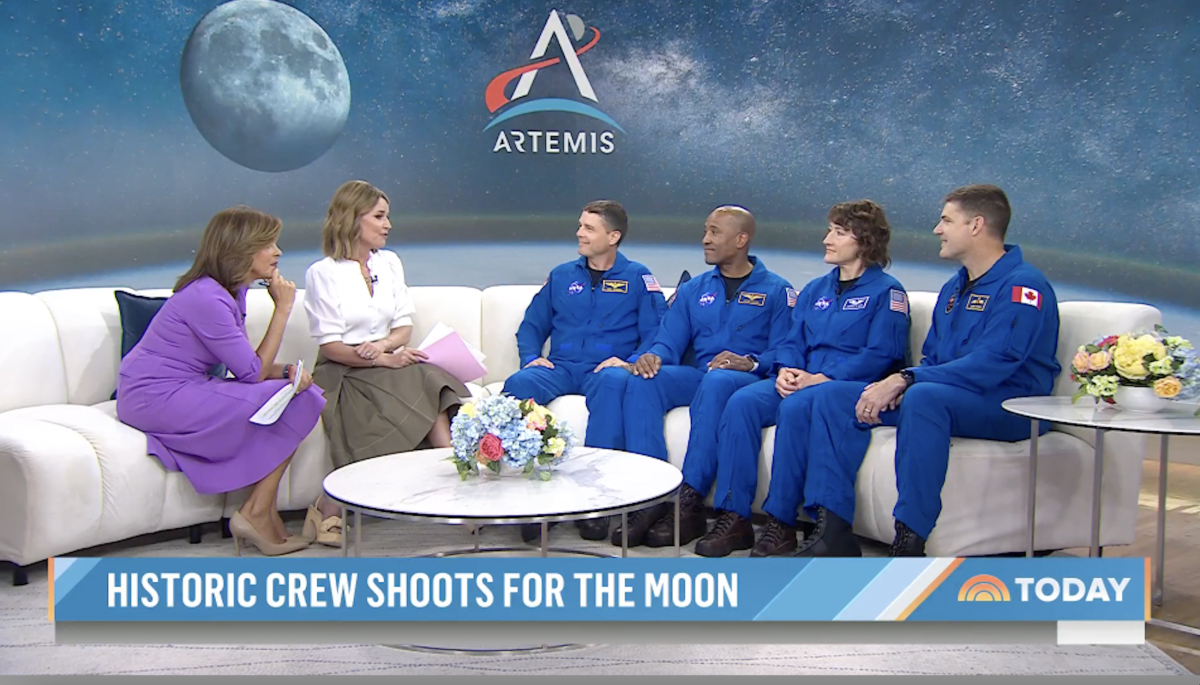A NASA instrument to provide unprecedented resolution of monitoring major air pollutants – down to four square miles – lifted off on its way to geostationary orbit at 12:30 a.m. EDT Friday.
Read MoreMonth: April 2023
Artemis 2 moon crew lands on ‘The Late Show with Stephen Colbert’ and ‘Today’
The first astronaut crew set to visit the moon in over 50 years just made a few publicity pit stops on Earth. NASA announced on Monday (April 3) that agency astronauts Reid Wiseman, Victor Glover and Christina Koch and Canada’s Jeremy Hansen will fly the Artemis 2 mission, a round-the-moon flight scheduled to launch in November 2024. The quartet landed on “The Late Show with Stephen Colbert” on Wednesday (April 5) and “The Today Show” on Thursday (April 6). During the visits, the team recalled their reactions to hearing they…
Read MoreDawn Aerospace’s space plane aces first rocket-powered flights (video)
Dawn Aerospace’s robotic space plane flew with a rocket engine for the first time last month, taking a major step toward the company’s goal of building a fully and rapidly reusable craft. Last week, the 15.7-foot-long (4.8 meters) Mk-II Aurora flew three times, and “all test objectives were achieved,” Dawn representatives said in a statement (opens in new tab) issued on Wednesday (April 5). The company also released a one-minute video showing the sleek space plane flying over New Zealand’s stunning South Island, close to the Glentanner Aerodrome where the…
Read MoreRings around Uranus! James Webb Space Telescope captures stunning image of ice giant (photo, video)
The James Webb Space Telescope (JWST) has captured an amazing image of Uranus, showing in great detail the ice giant’s ring system, its brightest moons and its dynamic atmosphere. The new observation, made on Feb. 6, follows a similarly stunning photo JWST captured recently of the solar system’s other ice giant, Neptune. The new Uranus image shows 11 of the planet’s 13 known rings, some of which are so bright that they blend together somewhat. What will really astound astronomers, however, is the fact that JWST‘s Near Infrared Camera (NIRCam)…
Read MoreNASA Administrator Names New Goddard Center Director
NASA Administrator Bill Nelson has named Dr. Makenzie Lystrup director of the agency’s Goddard Space Flight Center in Maryland, effective immediately. She will make history as the first female center director at Goddard.
Read MoreNASA Awards Innovative Concept Studies for Science, Exploration
Technology in development today could radically change the future of air and space exploration. Nearly silent electric aircraft could ferry people and packages around cities, a sprawling radio telescope array on the far side of the Moon could reveal new secrets about the universe, and astronauts on long-duration missions could grow their own medici
Read MoreArtemis II Crew Appears on “The Late Show”
The Artemis II crew appeared on “The Late Show with Stephen Colbert” on April 5, 2023.
Read MoreNASA Sets Coverage for Air Quality Instrument Launch
NASA and SpaceX are targeting no earlier than 12:30 a.m. EDT Friday, April 7, to launch NASA’s TEMPO (Tropospheric Emissions Monitoring of Pollution instrument). TEMPO is the first space-based instrument to monitor major air pollutants hourly in high spatial resolution – down to four square miles – in a region stretching from the Atlantic to the Pa
Read MoreWhat is ‘Star Trek’ First Contact Day and why do Trekkies care?
In our modern digital era often marred by political division and social media strife, we all could use a little bit of First Contact Day right about now. On April 5, we celebrate a pivotal “Star Trek” anniversary in that space fantasy’s dense mythology that altered the course of Earth’s inhabitants forever as depicted in the 1996 feature film “Star Trek: First Contact (opens in new tab).” It marks the historical moment on April 5, 2063 when humankind first encountered visitors of the Vulcan race after those logical point-eared aliens…
Read MoreMedieval lunar eclipse observations show how volcanoes affect Earth’s climate
Medieval tomes that recorded when the moon ranged in color from blood-red to pitch-black during lunar eclipses may help reveal vital clues about the volcanic eruptions that may have triggered the Little Ice Age in Europe, a new study finds. Volcanic eruptions can have major impacts on Earth by spewing out ash, gas and dust that can block light from the sun, triggering “volcanic winters.” For example, in 1815, Mount Tambora in Indonesia exploded in the largest volcanic eruption in recorded history, which led the following year, 1816, to become…
Read More